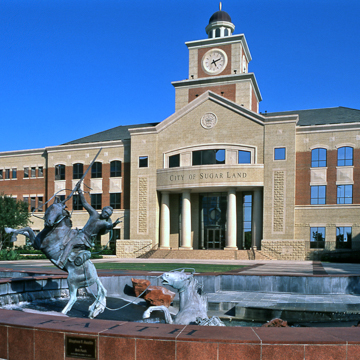Sale of the one-thousand-acre Imperial Ranch to Houston investors Jake Kamin, David Searls, and Stewart Morris in 1968 led to development of the Sugar Creek residential community, forecasting the ninety-seven-hundred-acre First Colony planned community, which opened in 1978 on Oyster Creek just upstream from Sugar Creek. By the early twenty-first century, First Colony had a population of nearly 46,000 living in sixty-six neighborhoods and was home to three hundred companies.
In 1998, Sugarland Properties and the City of Sugar Land embarked on a private-public joint venture to invent a thirty-two-acre “traditional” downtown at TX 6 and the Southwest Freeway (U.S. 59) , across from First Colony Mall of 1996 by RTKL of Dallas and adjoining The Market at Town Center of 1997, a collection of design-coordinated bigbox retail outlets. The spatial incongruity of this traditional downtown, with a Main Street flanked by tree-lined sidewalks and retail display windows; a mixture of retail, office, hotel, convention, and residential lofts occurring in street-defining low-rise and mid-rise buildings; and a civic plaza fronting Sugar Land City Hall (2004) by PGAL Architects of Houston, might seem dismaying in parts of the United States with a real tradition of small-town, suburban urbanity. In the booming corporate suburbs of early-twenty-first-century Texas, though, the town center represents an ideological turning point as planned communities acquired sufficient population that they sought to reinvent themselves as cities rather than agglomerations of subdivisions. The new typology embodied by Sugarland Town Center—the mixed-use traditional downtown built in a suburban parking lot next to a freeway—is called, in real estate terminology, a “lifestyle center.” The centerpiece of the town center is the public square by Houston landscape architects SLA Studio Land.

